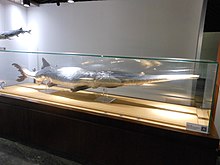Sword sturgeon
| Sword sturgeon | ||||||||||||
|---|---|---|---|---|---|---|---|---|---|---|---|---|

Sword sturgeon ( Psephurus gladius ) |
||||||||||||
| Systematics | ||||||||||||
|
||||||||||||
| Scientific name of the genus | ||||||||||||
| Psephurus | ||||||||||||
| Günther , 1873 | ||||||||||||
| Scientific name of the species | ||||||||||||
| Psephurus gladius | ||||||||||||
| ( Martens , 1862) |

The Chinese paddlefish ( Psephurus gladius ; Chinese abbreviation :白鲟; pinyin : báixún ; English: Chinese paddlefish, also known as Chinese Swordfish ) is the only kind of monotypic genus Psephurus . Its closest relative is the American paddlefish ( Polyodon spathula ) in the family of paddlefish . The sword sturgeon was endemic to the Yangtze River in China. The species was considered critically endangered and is listed in Appendix II of the Washington Convention on Endangered Species.
The sword sturgeon has been considered extinct since the end of 2019.
features
The forehead was drawn out into a mighty appendage that reached about a third of the total length of the fish. Sword sturgeon became more than three meters long and weighed up to 500 kg (information about previously greater lengths, up to 7 m, is not impossible, but should be taken with great care). The eyes were very small and weak (the Yangtze is always cloudy). A big mouth was used by the predatory fish to catch fish. Apparently he could slur up schools of small fish by straining them. But it also ate crustaceans from the bottom. The upper lobe of the caudal fin was covered with large, shiny ganoid scales, which explains the generic name: ( Old Greek) Psephurus means "smooth tail " (from psēphos "smooth pebble").
Due to the whitish color, bare skin, short fins, wide gill cover hem and a slight ossification of the cartilage velcro, the fish made an "immature" impression despite its size, so that Grande and Bemis even compared it with the in their large comparative osteological study (1991) Compare pedomorphic axolotl .
Way of life
The sword sturgeon was endemic in China in the Yangtze , in the upper, middle and lower reaches . Developing zygotes and juvenile fish were found only above the city of Luzhou , in Sichuan Province . He has mainly on small fish such as freshwater cyprinids , Coreius , Rhinogobius , Gobius , Bagriden , crab or shrimp feeds.
Males reached sexual maturity at five to ten years of age, females only at six to fifteen years. During the spring floods in March and April, the animals migrated upriver to lay their spawn. Where their spawning grounds were located is given imprecisely as "on the upper reaches of the Yangtze River". The eggs were laid in muddy, sandy to rocky ground, in open water, at a depth of up to 10 m. The spawn consisted of over 100,000 eggs 2.7 mm in diameter per ovary. The ideal water temperature is 18 to 20 ° C. The spawn was not guarded by the parents.
Danger
The stock has long declined due to overfishing and water pollution. The animals also suffered fatal injuries from the steadily increasing shipping traffic. The construction of the Gezhouba Dam (construction period 1970 to 1988) made his migration in the lower reaches of the Yangtze impossible. Young fish were last caught in the lower reaches in 1995. Two adult females were found in 2002. In 2004 the last specimens held in captivity died. All attempts to breed the fish were unsuccessful.
From 2006 to 2008, complex hydroacoustic measurements with an echo sounder were carried out in the upper reaches of the Yangtze between Xinshi and Chongqing (490 km). Only nine fish could be detected. The Chinese paddlefish is in the red list of the IUCN "critically endangered (possibly extinct)" as performed (as of 2010).
Zhang et al. (2019) assume that the sword sturgeon became extinct between 2005 and 2010.
Web links
swell
- ^ Joseph S. Nelson : Fishes of the World. John Wiley & Sons, 2006, ISBN 0-471-25031-7 , p. 94.
- ↑ a b IUCN: Chinese paddle fish. Psephurus gladius. in the IUCN Red List of October 24, 2009. Accessed March 11, 2019.
- ↑ a b Hui Zhang, Ivan Jarić, David L. Roberts, Yongfeng He, Hao Du: Extinction of one of the world's largest freshwater fishes: Lessons for conserving the endangered Yangtze fauna . In: Science of The Total Environment . December 23, 2019, ISSN 0048-9697 , doi : 10.1016 / j.scitotenv.2019.136242 ( sciencedirect.com ).
- ^ Johann Grolle, DER SPIEGEL: Threatened giant animals: The hidden world of the freshwater giants - DER SPIEGEL - Science. Retrieved February 7, 2020 .
- ↑ a b FishBase : Psephurus gladius , sword sturgeon. Retrieved March 11, 2019.
- ^ Wilhelm Pape: Concise dictionary of the Greek language. 3. Edition. 1880. (Reprinted 1914). (www.zeno.org Accessed March 11, 2019)
- ^ A b Food and Agriculture Organization of the United Nations: Species Fact Sheet: Psephurus gladius (Martens, 1862). the FAO . Retrieved March 11, 2019.
- ↑ a b The Eerie Sadness of China's Paddlefish. In: The Orbit. November 7, 2017. (the-orbit.net , accessed March 11, 2019)
- ↑ H. Zhang, QW Wei, H. Du, L. Shen, YH Li, Y. Zhao: Is there evidence that the Chinese paddlefish (Psephurus gladius) still survives in the upper Yangtze River? Concerns inferred from hydroacoustic and capture surveys, 2006–2008. Journal of Applied Ichthyology 25 (s2) pp. 95 - 99, September 2009 doi : 10.1111 / j.1439-0426.2009.01268.x